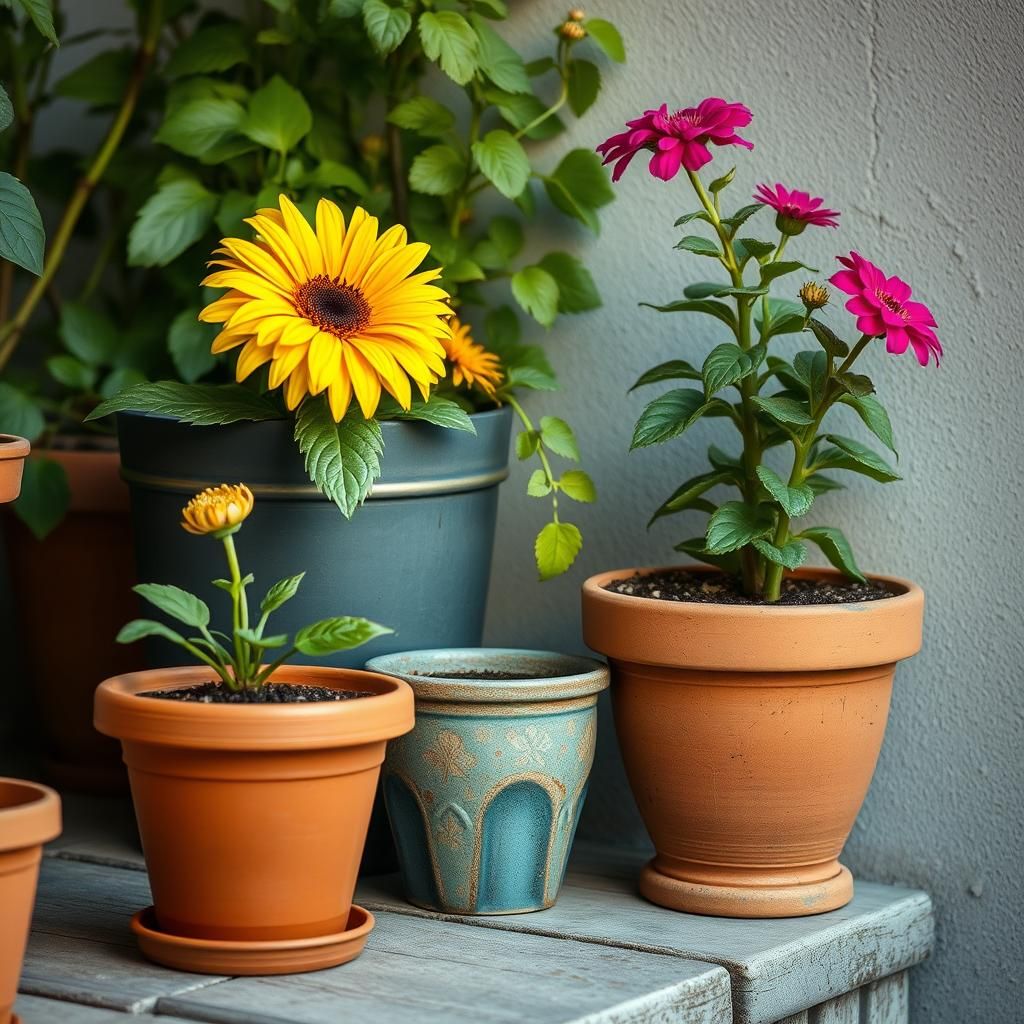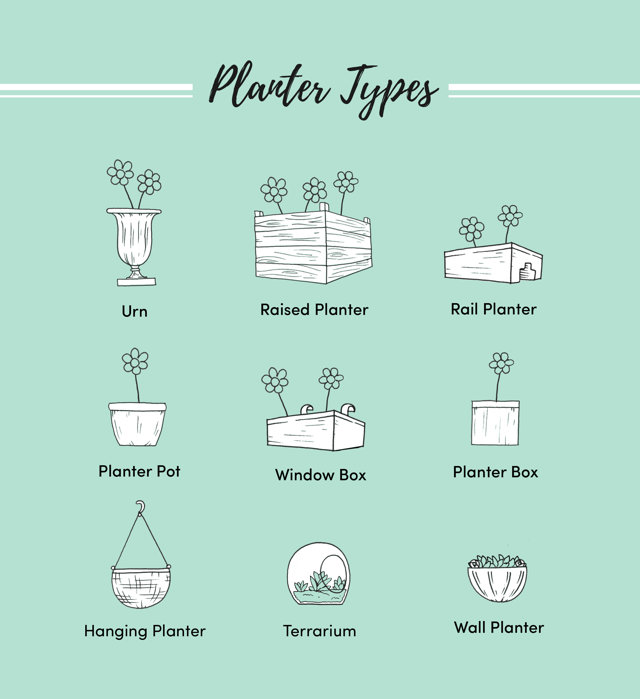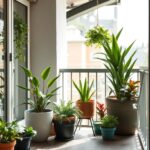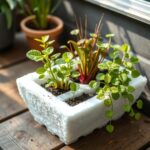What is the Difference Between a Planter and a Flowerpot? Understanding Their Unique Roles in Gardening

When it comes to gardening, the terms planter and flowerpot are often used interchangeably, but they serve distinct purposes and functions. Understanding the differences between these two essential gardening tools can enhance your planting experience and ensure optimal growth for your plants. Planters typically refer to larger, more decorative containers that may accommodate multiple plants, while flowerpots are usually smaller and designed for single plants. This article delves into the unique roles of each, exploring their characteristics, materials, and best uses to help you make informed choices in your gardening endeavors.
What is the Difference Between a Planter and a Flowerpot?
When distinguishing between a planter and a flowerpot, the primary difference lies in their size and functionality. A flowerpot is typically smaller and designed to hold a single plant, making it ideal for indoor use and decorative purposes. In contrast, a planter is often larger, accommodating multiple plants or even an entire garden arrangement. Planters are more versatile as they can be used in various settings, such as outdoors on patios or in gardens, and may contain a built-in drainage system to ensure optimal soil moisture and plant health. Therefore, while both serve the purpose of holding plants, their design and practical applications differ significantly.
Size Comparison
The size is a crucial factor when comparing planters and flowerpots. Flowerpots are generally smaller, typically ranging from a few inches to around one foot in diameter, making them suitable for individual houseplants or small flowering plants. On the other hand, planters can be much larger, sometimes several feet across, and designed to house multiple plants, creating an outdoor feature or a sizeable interior arrangement. This variance in size affects how both containers are used in gardening and decor.
Material Differences
The materials used for crafting planters and flowerpots can vary widely. Flowerpots are often made from ceramics, plastic, or metal, which allow for a diverse array of designs and colors. Conversely, planters can be constructed from similar materials, but they are also frequently made from wood, concrete, or stone, as these materials provide additional durability and support for larger plants. The choice of material influences the aesthetic appeal and longevity of each type of container.
Drainage Features
Another significant difference between planters and flowerpots concerns their drainage features. While most flowerpots have a drainage hole at the bottom to prevent water from accumulating, allowing for healthy root systems, planters often incorporate advanced drainage options, including a reservoir system. This feature benefits larger plants or multiple plant arrangements, ensuring that excess water can escape and prevents root rot. The effective drainage system is vital for maintaining plant health, especially in outdoor conditions.
Usage and Versatility
Planters typically offer more versatility in their usage compared to flowerpots. While flowerpots are often used solely for individual plants and indoor decoration, planters can serve multiple roles, such as in landscaping, patio decoration, or even as standalone art pieces in a garden. Their adaptability allows gardeners to create unique arrangements and display combinations of flowers, herbs, or shrubs, which can enhance both indoor and outdoor environments. This versatility makes planters a popular choice for both amateur gardeners and professional landscapers.
Aesthetic Considerations
Aesthetics play a significant role in the selection of planters versus flowerpots. Flowerpots are often designed with an emphasis on artistic appearances, as they come in various colors, shapes, and styles that cater to interior decor. On the contrary, planters prioritize functionality but can still be visually appealing, as they are available in larger formats that create stunning focal points in gardens and terraces. The aesthetic choice between the two usually depends on the setting and the visual impact the gardener wishes to achieve.
| Feature | Flowerpot | Planter |
|---|---|---|
| Size | Smaller | Larger |
| Materials | Ceramics, Plastic, Metal | Wood, Concrete, Stone, etc. |
| Drainage | Single drainage hole | Advanced drainage options |
| Usage | Individual plants | Multiple plants, decorative features |
| Aesthetic | Artistic focus | Functional but can be decorative |
What is considered a planter?

A planter is typically defined as a container or vessel that is used for growing plants. These containers come in a variety of shapes, sizes, and materials, allowing for a wide range of gardening options, both indoors and outdoors. A planter is designed to hold soil and provide the necessary drainage for plants, making it an essential component in horticulture. Some planters are specifically designed to accommodate certain plant types, while others can be quite versatile.
Types of Planters
Different types of planters can be categorized based on their material, design, and use.
- Containers: These can include pots, boxes, or other vessels used to hold soil and plants.
- Vertical planters: These are designed to maximize space, allowing plants to grow upwards in a small area.
- Raised beds: Larger structures that allow for more substantial gardening efforts, typically elevated off the ground.
Materials Used for Planters
Planters can be made from various materials, each offering unique benefits and drawbacks.
- Plastic: Lightweight and affordable, they are resistant to weather changes but may lack proper drainage.
- Ceramic: Often aesthetically pleasing, these planters are durable but can be heavy and fragile.
- Wood: Provides a natural look and good insulation, but may require treatment to prevent decay.
Features of Planters
Understanding the features of planters can help gardeners choose the best option for their plants.
See also:
- Dr drainage holes: Essential for preventing root rot, ensuring that excess water can escape.
- Size: Varies significantly, which affects how many and what type of plants can be grown.
- Mobility: Some planters come with wheels or are lightweight for easy relocation.
Using Planters for Landscaping
Planters play a significant role in landscaping, adding visual interest and enhancing outdoor spaces.
- Enhancing aesthetics: They can be used to create focal points in a garden.
- Seasonal displays: Planters can be changed out with different plants based on seasonal themes.
- Defining spaces: They can help to define areas such as walkways or entrances.
Indoor vs. Outdoor Planters
The differences between indoor and outdoor planters are significant, affecting the types of plants suited for each environment.
- Indoor planters: Often designed to complement home décor, these may have decorative features and are usually smaller.
- Outdoor planters: Built to endure harsher weather conditions, they are generally larger and sturdier.
- Drainage systems: Outdoor planters often have more extensive drainage solutions to handle rainwater.
What are the three types of planters?

There are three primary types of planters that gardeners commonly use: in-ground planters, raised planters, and container planters. Each type serves a specific purpose and is suited to different gardening styles and preferences.
In-Ground Planters
In-ground planters refer to planting directly into the soil of the ground. This method allows plants to access the natural soil, nutrients, and microorganisms present in the earth. In-ground planters are typically used for large gardens and landscape beds.
- Benefits: They promote deep root growth and access to natural resources.
- Considerations: Soil quality must be good, and drainage needs to be managed effectively.
- Best For: Perennials, shrubs, and trees that require ample space.
Raised Planters
Raised planters are elevated garden beds that are filled with soil and offer an organized way to plant various crops. They are typically constructed from wood, stone, or other materials and provide excellent drainage while keeping plants at a more accessible height for gardeners.
- Advantages: Easier on the back and knees while planting and maintaining.
- Soil Quality: Allows for controlled soil conditions, which can be tailored to specific plants.
- Versatility: Great for vegetables, herbs, and flowers, and can be placed in small spaces.
Container Planters
Container planters are pots or other vessels used to grow plants. They are particularly useful when space is limited or for urban gardening. Container gardening allows for flexibility, as you can move the plants as needed for sun exposure or aesthetic appeal.
- Mobility: Easy to relocate to find the best sunlight or protect from harsh weather.
- Variety: Available in many shapes, sizes, and materials, allowing for creative arrangements.
- Suitable For: Small plants, herbs, and even some larger plants when using big containers.
What is a flowerpot?

A flowerpot is a container, typically made of clay, plastic, or other materials, designed to hold soil and support the growth of plants. Flowerpots serve multiple purposes, including providing a space for roots to grow, facilitating drainage, and allowing for easy transportation and arrangement of plants in both indoor and outdoor environments. They come in various shapes, sizes, and designs, catering to different types of plants and aesthetic preferences.
Types of Flowerpots
Different types of flowerpots are available, each serving specific purposes and functions:
- Terra Cotta Pots: Traditional clay pots that are porous, allowing for air and moisture exchange.
- Plastic Pots: Lightweight and durable, often using recycled materials, making them economical and versatile.
- Fabric Pots: Made from breathable materials, promoting healthy root development by preventing root circling.
Materials Used in Flowerpots
Flowerpots can be made from a variety of materials, each with its own benefits:
- Clay: Offers excellent drainage and breathability but can be heavy and breakable.
- Plastic: Lightweight and available in numerous colors and styles, though it may not provide the same breathability as clay.
- Metal: Provides a modern aesthetic but requires careful attention to insulation as it can heat up quickly.
Importance of Drainage in Flowerpots
Proper drainage is crucial for the health of the plants housed in flowerpots:
See also:
- Prevents Overwatering: Ensures excess water escapes, reducing the risk of root rot.
- Promotes Aeration: Allows oxygen to reach the roots, supporting healthy growth.
- Maintains Soil Health: Helps in balancing moisture levels, promoting the growth of beneficial microorganisms.
Caring for Flowerpots
Maintaining flowerpots is essential for the longevity of both the pots and the plants they contain:
- Regular Cleaning: Remove any debris to prevent disease and bacterial growth.
- Routine Inspections: Check for cracks or deterioration that can affect the pot’s integrity.
- Seasonal Changes: Adapt potting mixes and care for different seasonal plant needs.
Choosing the Right Flowerpot
Selecting the appropriate flowerpot for a specific plant can influence growth and aesthetics:
- Size Consideration: Ensure the pot is appropriately sized for the plant's root system.
- Style Selection: Match the flowerpot with the decor and the type of plant for a cohesive appearance.
- Functionality: Choose pots designed for indoor or outdoor use according to environmental conditions.
Are they called pots or planters?

The distinction between whether to refer to them as pots or planters can often depend on their size, shape, and intended use. Generally, both terms are used in gardening and horticulture, but there are some differences that help clarify their usage.
Definition of Pots
Pots are typically defined as small to medium-sized containers used primarily for individual plants. They often have drainage holes at the bottom to allow excess water to escape, which helps prevent root rot.
- Size: Pots are generally smaller than planters, designed to hold a single plant or a few plants in one container.
- Material: They can be made from various materials including plastic, clay, or ceramic.
- Mobility: Due to their lighter weight and smaller size, pots are often more mobile, allowing them to be moved easily indoors or outdoors.
Definition of Planters
Planters, on the other hand, are generally larger and designed to hold multiple plants. They can be used both indoors and outdoors and come in a variety of shapes and styles.
- Size: Planters are usually larger than pots and can accommodate several plants at once, making them suitable for flower arrangements or vegetable gardens.
- Design: They often feature decorative aspects, allowing them to serve not just a functional purpose, but also an aesthetic one in landscaping.
- Drainage: While many planters come with drainage holes, some types may require additional attention to water management to prevent flooding.
Common Materials Used
Both pots and planters can be made from a variety of materials, each influencing both their functionality and aesthetic appeal.
- Ceramic: Often used for both pots and planters, ceramic is attractive but can be heavy and prone to breakage.
- Plastic: Lightweight and durable, plastic pots and planters are widely popular for their functionality and variety of styles.
- Wood: Wooden planters can create a rustic look, but may require treatment to withstand the elements.
Usage Considerations
When deciding between pots and planters, several practical considerations may influence your choice.
- Space: If space is limited, a pot is often a better option for a single plant.
- Plant Type: Larger plants or arrangements may thrive better in a planter, providing the necessary room for roots to expand.
- Location: Consider where the container will be used; outdoor planters may need to withstand weather conditions better than smaller indoor pots.
Choosing the Right Container
Selecting the appropriate container for your plants sits at the intersection of practicality and aesthetics.
- Functionality: Choose containers based on drainage needs and the types of plants you intend to grow.
- Style: Align the choice of pots or planters with the overall decor and design of your space.
- Mobility: For seasonal changes, consider how often you'll need to move the container, favoring lighter options when necessary.
Questions from Our Readers
What is a planter?
A planter is typically a larger container designed for holding a variety of plants, including flowers, vegetables, and shrubs. Planters often feature drainage holes and are used for both indoor and outdoor gardening, allowing for greater flexibility in landscaping and decorative design.
What is a flowerpot?
A flowerpot is usually a smaller container primarily intended for growing individual plants or flowers. These pots come in various shapes and sizes and are often made from materials like clay, plastic, or ceramic, making them suitable for home decor and indoor gardening.
Can a flowerpot be used as a planter?
Yes, a flowerpot can function as a planter, particularly if it is large enough to accommodate multiple plants. However, it is generally more limited in scope compared to dedicated planters that offer more space and versatility for plant arrangements.
See also:
Are there any differences in design between planters and flowerpots?
Yes, while both are used for gardening, planters often feature more decorative designs and larger dimensions, while flowerpots tend to have simpler designs and are usually smaller, focusing more on functionality for individual plants.

If you want to read more articles like What is the Difference Between a Planter and a Flowerpot? Understanding Their Unique Roles in Gardening, we recommend you check out our Planter category.
Leave a Reply
Related Articles